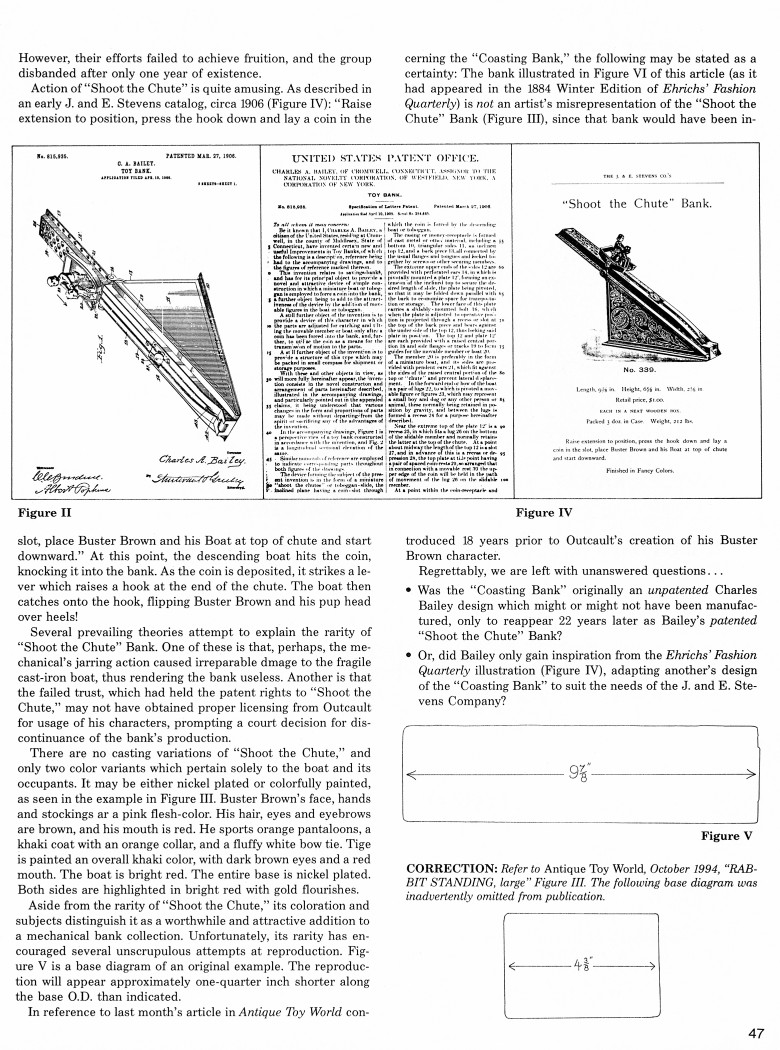|
The Coasting and the Shoot the Chute Bank
A mystery and a history, Part II
by Sy Schreckinger – ANTIQUE TOY WORLD Magazine – December, 1994
During the last decade of the 19th century, a
brilliant cartoonist created what was to become a national institution.
Richard F. Outcault was the originator of the first full-color Sunday
comic strip in the United States. His creation was entitled "Hogan's
Alley" and featured a crude, ungainly youth named the "Yellow Kid."
Although the strip was extremely popular with a segment of the
population, Outcault became dissatisfied with the "vulgarity" of its "low
class" characters and decided to terminate the column in 1898.
Four years later, in 1902, he sired another strip, characterizing a
"more refined," albeit brat-like youngster named Buster Brown. The child
was frequently accompanied by his faithful dog, Tige (Figure I), who
possessed the amazing powers of speech. The comic duo enjoyed immediate
success. Their exploits appeared in several New York newspapers until
their termination in 1920. For almost 40 years, the images of Buster and
Tige adorned various categories of consumer goods. Endorsements included:
books, clothing, umbrellas, raisins, soap, buttons, cigars, whiskey, hair
cuts, shoes and toys.
It was during the pinnacle of Buster Brown's popularity that Charles
A. Bailey, one of the world's leading mechanical bank designers,
capitalized upon Outcault's characters. He incorporated them into one of
his own creations (Figure II), for which he was granted Patent Number
815,935 on March 27, 1906. The bank was eventually manufactured by the J.
and E. Stevens Company of Cromwell, Conn. (Figure III).
Interestingly, the aforementioned papers indicate that Bailey
originally assigned his invention to the National Novelty Corporation of
Westfield, N.Y. This was a trust composed of several of the major toy
manufacturers of the day, and included the J. and E. Stevens Company. The
trust planned to pool their production and monopolize the toy market.
However, their efforts failed to achieve fruition, and the group disbanded
after only one year of existence.
Action of "Shoot the Chute" is quite amusing. As described in an
early J. and E. Stevens catalog, circa 1906 (Figure IV): "Raise extension
to position, press the hook down and lay a coin in the slot, place Buster
Brown and his Boat at top of chute and start downward." At this point, the
descending boat hits the coin, knocking it into the bank. As the coin is
deposited, it strikes a lever which raises a hook at the end of the
chute. The boat then catches onto the hook, flipping Buster Brown and his
pup head over heels!
Several prevailing theories attempt to explain the rarity of "Shoot
the Chute" Bank. One of these is that, perhaps, the mechanical's jarring
action caused irreparable damage to the fragile cast-iron boat, thus
rendering the bank useless. Another is that the failed trust, which had
held the patent rights to "Shoot the Chute," may not have obtained proper
licensing from Outcault for usage of his characters, prompting a court
decision for discontinuance of the bank's production.
There are no casting variations of "Shoot the Chute," and only two
color variants which pertain solely to the boat and its occupants. It may
be either nickel plated or colorfully painted, as seen in the example in
Figure III. Buster Brown's face, hands and stockings are a pink
flesh-color. His hair, eyes and eyebrows are brown, and his mouth is red.
He sports orange pantaloons, a khaki coat with an orange collar, and a
fluffy white bow tie. Tige is painted an overall khaki color, with dark
brown eyes and a red mouth. The boat is bright red. The entire base is
nickel plated. Both sides are highlighted in bright red with gold
flourishes.
Aside from the rarity of "Shoot the Chute," its coloration and
subjects distinguish it as a worthwhile and attractive addition to a
mechanical bank collection. Unfortunately, its rarity has encouraged
several unscrupulous attempts at reproduction. Figure V is a base diagram
of an original example. The reproduction will appear approximately
one-quarter inch shorter along the base O.D. than indicated.
In reference to last month's article in Antique Toy World concerning
the "Coasting Bank," the following may be stated as a certainty: The bank
illustrated in Figure VI of this article (as it had appeared in the 1884
Winter Edition of Ehrichs' Fashion Quarterly) is not an artist's
misrepresentation of the "Shoot the Chute" Bank (Figure III), since that
bank would have been introduced 18 years prior to Outcault's creation of
his Buster Brown character.
Regrettably, we are left with unanswered questions...
• Was the "Coasting Bank" originally an unpatented Charles Bailey
design which might or might not have been manufactured, only to reappear
22 years later as Bailey's patented "Shoot the Chute" Bank?
• Or, did Bailey only gain inspiration from the Ehrichs'Fashion
Quarterly illustration (Figure IV), adapting another's design of the
"Coasting Bank" to suit the needs of the J. and E. Stevens Company?
CORRECTION: Refer to Antique Toy World,
October 1994, "RABBIT
STANDING, large" Figure III. The following base diagram was inadvertently
omitted from publication.
|


